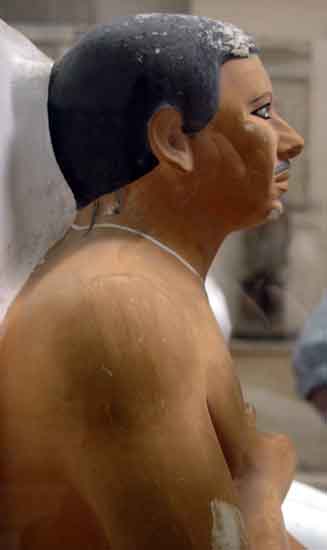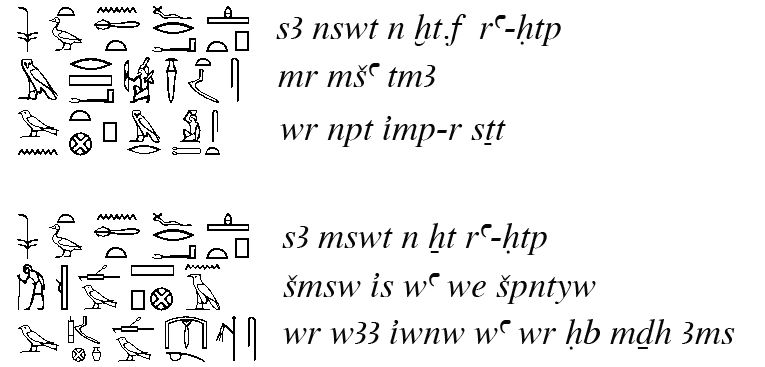-
- Painted limestone statues of Ra-Hotep and his
wife Nofret excavated in 1871 by Mariette at Meidum, Mastaba of
Ra-Hotep, 4th Dynasty during the reign of Sneferu (ruled c.2575-2551
BC).
- The statues depicting Prince Ra-Hotep and his
wife Nofret are they were found in Ra-Hotep's mastaba north of Snefru's pyramid. The two figures are seated on
square-cut chairs with high backrests that are only slightly lower than their heads. Ra-Hotep's
chair is slightly wider than Nofret's.
- Ra-Hotep is represented with his right arm
folded across his chest and his left resting on the left leg. Both his
hands are closed. He is wearing a short black wig that leaves his thin
face and high forehead completely uncovered. His facial features are
carved with great realism. The large eyes are inlaid with quartz and
rock crystal and are outlined with heavy black eye-paint and surmounted
by painted eyebrows. The nose is well shaped and the rather large mouth
is highlighted by a black-painted moustache. Around his neck he is
wearing a thin chain and pendant. He is clothed only in a short white
kilt. His torso and arms display a well-balanced and powerful
musculature, while his legs and feet are rather heavy.
-
- On the back of the chair on either side of his
head are three columns of painted hieroglyphs listing his titles and
name. He is defined as 'son of the king of his body' and among his other
titles were 'Priest of Re at Heliopolis, superintendent of works, and
superintendent of expeditions'.
- Nofret is depicted with her arms folded,
swathed in a cloak. The cloak, from which her right hand emerges, wraps
around her tight tunic and reveals the forms of her body. Around her
neck is a usekh necklace with strings of beads of
alternating colours: light and dark blue, and red, ending in a row of
blue pendants. Her heavy black wig descends to her shoulders and is
hound around her forehead by a band decorated with floral motifs. Her
face is quite full and has delicate features. The inset eyes are
slightly narrower than those of Ra-Hotep. The nose is small with gentle
curves, and the mouth is also small with fleshy lips. On the backrest,
on either side of her head, an inscription reads 'She who knows the King
Nofret'. The difference in the skin colour of the two figures follows
the usual Egyptian practice in depicting males and females. Male figures
are always ochre (sometimes almost red) while females are painted a pale
yellow.
- In spite of the rigidity of the pose and the
fixed gaze, these two statues reveal the artist's great skill in giving
life to stone images. Even if we did not have the inscriptions to
identify the two figures as members of the royal circle, the high
quality of the sculptures would be sufficient to reveal them as the work
of court artists.
-
-




